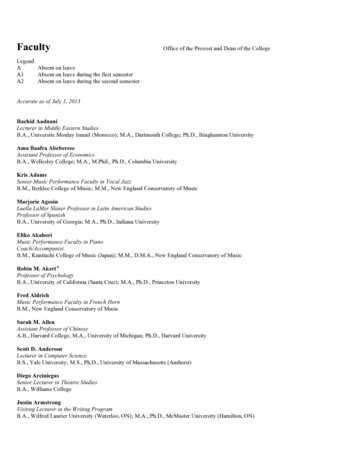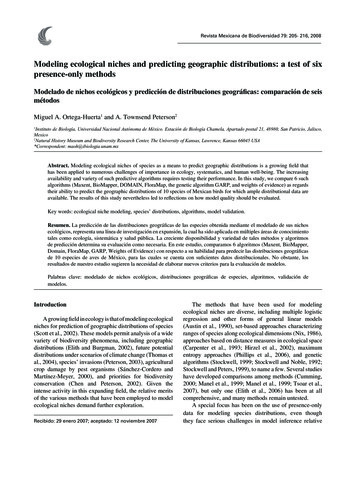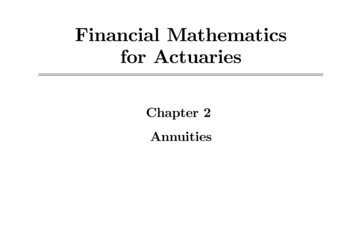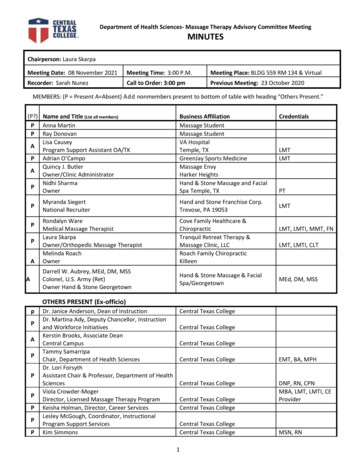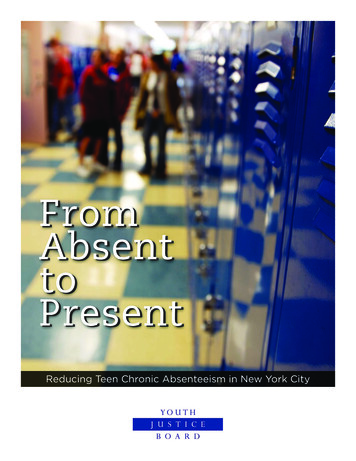
Transcription
FromAbsenttoPresentReducing Teen Chronic Absenteeism in New York City
Photo credit: ChristianThis publication was written byYouth Justice Board members and staff.The Youth Justice Board is a project of the Center for Court Innovation.It was established to give young people a voice in policies that affect theirlives. Each year a team of high school students from across New York Cityinvestigates a current juvenile justice or public safety issue, formulates policyrecommendations, and works to promote and implement key ideas.Funding for the Youth Justice Board has come from the Center for UrbanPedagogy’s Making Policy Public Program, Cricket Island Foundation, Edward& Ellen Roche Relief Foundation, the New York Bar Foundation, the New YorkCity Council, the New York State Unified Court System, Surdna Foundation,Taconic Foundation, and W. Clement & Jessie V. Stone Foundation.Points of view and opinions expressed in this document are the opinions of theYouth Justice Board members and do not necessarily represent the official positionor policies of the Center for Court Innovation or the above-named entities.June 2013
Dear ReaderWe are a group of diverse teenagers who came together to study truancy andchronic absenteeism among teenagers in New York City schools. We all haddifferent reasons for joining the Youth Justice Board, but our common goal isto improve attendance in the New York City public school system.We want to raise student attendance rates by improving school-student relationships throughout New York City public schools. This issue is importantto us because, for some of us, we have struggled with school attendance,and for others, it has affected our friends and family members. We knowpeople who could be doing better things with their lives, but need help reconnecting with school or other educational alternatives.We spent several months researching this topic. We conducted interviewswith stakeholders, met with the Chair of the Mayor’s Interagency Task Forceon Truancy, Chronic Absenteeism, and School Engagement, visited schools,and held focus groups with young people who have experience with truancyand chronic absenteeism. We then developed ten recommendations that webelieve can improve the lives of young people by increasing attendance ratesin the public school system.We hope that our recommendations can help decrease the number of truantand chronically absent students in New York City public schools and can, inturn, improve the educational system, save money for New York City, and giveyoung people more choices in life.Thank you for reading our report and recommendations.Sincerely,THE YOUTH JUSTICE BOARD1
AcknowledgementsINTERVIEWEES:OTHER PROGRAM SUPPORTERS:Anna Bean, Ana Bermudez, Amy Breglio,Hedy Chang, Leslie Cornfeld, Hon. MonicaDrinane, Evan Elkin, Bobby Ferazi, KathleenHoskins, Sarah Jonas, Joshua Laub, KimNauer, Lisa Nelson, Joseph Notaro, KimSuttell, and the 21 young people whoparticipated in the focus groups*Hannah LucalYOUTH JUSTICE BOARD ALUMNI:Ali, Brianna, Khaair, Melvin, Nathalia, Phelipe,Syeda, Toni, TyanneYOUTH JUSTICE BOARD PHOTOGRAPHERS:Christian, Terry-AnnCENTER FOR COURT INNOVATION:Liberty Aldrich, Taí Merey Alex, SoniaBalaram, Greg Berman, Matthew Bond, BethBroderick, Damon Brown-Dobbs, CourtneyBryan, Sharon Bryant, Ruby-Beth Buitekant,Hon. Alex Calabrese, Sabrina Carter, KatieCrank, Carmen Facciolo, Rachel Finkelstein,Nancy Fishman, Carol Fisler, Adelle Fontanet,Emily Gold, Jaclyn Green-Stock, Dory Hack,Elise Jensen, Hon. Eileen Koretz, Amy Levitt, Leticia Lucero, Michele Maestri, KarinaPantoja, Dana Rachlin, Chante Ramsey,Amanda Roaf, Sally Sanchez, Sarah Schweig,Alfred Siegel, Brett Taylor, Brett Vetterlein,Luisana Victorica, Chris Watler, Rob WolfDESIGN:Megan McConaghaPhoto credit: Terry-Ann* The names of the youths in the focus groups are withheld to protect their privacy2
Table of Contents3ACKNOWLEDGEMENTS2TABLE OF CONTENTS3EXECUTIVE SUMMARY4INTRODUCTION5FINDINGS8RECOMMENDATIONS13A. IDENTIFYING AND DEFINING THE ISSUE14B. CONNECTING ATTENDANCE TO FUTURE OUTCOMES17C. ADDRESSING STRUCTURAL BARRIERS TO SCHOOL ATTENDANCE21D. PROVIDING INTERVENTIONS FOR YOUTHS AFFECTED BY, OR AT-RISK FOR, CHRONIC ABSENTEEISM26CONCLUSION33WORKS CITED34YOUTH JUSTICE BOARD MEMBER AND STAFF BIOGRAPHIES36APPENDIX 1: RESEARCH DESIGN40APPENDIX 2: THE YOUTH JUSTICE BOARD PROGRAM42
Executive SummaryThis report presents the findings and recommendations of the Youth Justice Board, an afterschool program that engages New York City teenagers in studying public policy issues that affect young people. Since August 2012, the Youth Justice Board has focused on reducing chronicabsenteeism among teenagers in the city. This issue is important to Board members because itaffects so many teens: citywide, about one in three students is considered “chronically absent,”missing 10 percent or more of the school year. This report presents ideas about how differentindividuals and institutions can work together to improve attendance rates citywide. In the 201314 program year, the Board will work to implement many of the ideas contained in this report.The Board’s ultimate goal is to improve attendance and the overall school experience for youngpeople in New York City.Over four months, the Youth Justice Board conducted interviews with 19 experts doing work related to the issues of school truancy and chronic absenteeism. The Board also conducted threefocus groups with young people who have personal experience with these issues. The YouthJustice Board developed ten recommendations to improve school attendance in New York City:A.B.C.D.IDENTIFYING AND DEFINING THE ISSUE1. Use “chronic absenteeism” rather than “truancy” to refer to attendance issues2. Use individual attendance data in addition to school average daily attendance todetermine more efficiently which students struggle with attendanceCONNECTING ATTENDANCE TO FUTURE OUTCOMES3. Support parents and foster parents to ensure that they are familiar with the educationsystem and the importance of daily school attendance4. Help teens draw connections between school attendance and their futures earlyin their schoolingADDRESSING STRUCTURAL BARRIERS TO SCHOOL ATTENDANCE5. Examine the impact of security procedures on student attendance6. Develop clear, consistent expectations around student confidentiality7. Offer additional supportive services to students during transition periodsPROVIDING INTERVENTIONS FOR YOUTHS AFFECTED BY, OR AT-RISK FOR, CHRONIC ABSENTEEISM8. Prepare schools to support students who are returning from extended absences9. Expand supports for over-age, under-credited students10. Have mentoring programs available in all schools to give chronically absent students the attention and concern that will inspire commitment to attend school4
IntroductionEach year, more than 5 million students acrossthe country are considered chronically absent,missing more than 10 percent of the schoolyear.1 In New York City more than a quartermillion students — nearly one in three studentsin certain neighborhoods — are chronicallyabsent each year.2 Chronic absenteeism refersto all absence, including both excused and unexcused absences. Under-aged students whomiss any amount of school without an excusefrom a parent or guardian are considered truant, a status offense. In New York State, youngpeople are required to attend school until theend of the school year in which they turn 16years old. For 16 year olds without jobs, statelaws provide school districts with the authority to require full-time attendance until the endof the school year in which they turn 17 yearsold.3 This report focuses on chronically absentstudents, as research indicates that truancy isan expression of some of the risk factors thatcontribute to chronic absenteeism.In New York City, principals at individualschools are responsible for attendance, including individual cases of truancy and chronicabsence. Although the Department of Education (DOE) monitors system-wide studentattendance through its computerized Atten-1234565dance Tracking System (ATS), the DOE lacksthe authority to intervene directly in individualschools.4 Outside of schools, starting in 2001,the Police Athletic League (PAL) and variouscity agencies worked together to operate Partnership Against City Truancy (PACT) centersto provide resources to truant youths.5 Thetruancy centers ceased operations when PACTdissolved in 2012. Currently, the NYPD hasthe primary responsibility for engaging truantyouths.There can be legal ramifications for bothstudents and families when students are labeled truant or chronically absent. In particular, chronically absent youths risk involvementwith the Administration for Children’s Services(ACS), New York City’s child welfare agency.If a youth misses a certain amount of school(typically 10 consecutive days or 20 days overthe course of a four-month period), the child’sparents/guardians can be reported to the childprotective system via an electronic 407 attendance alert on the charge of educationalneglect.6 This can lead to a case in FamilyCourt. In addition, youths may be subject toPINS proceedings or other involvement in court.The 407 alerts, generated by the ATS, help inform schools of attendance issues, but researchBalfanz, R., & Byrnes, V. (2012). The Importance of Being in School: A Report on Absenteeism in the Nation’s Schools, 3. Retrieved ads/2012/05/FINALChronicAbsenteeismReport May16.pdfIbid., 7 and Nauer, K., White, A., & Yerneni, R. (2008). Strengthening Schools by Strengthening Families: Community Strategies toReverse Chronic Absenteeism in the Early Grades and Improve Supports for Children and Families, 7. Retrieved from ts/StrengtheningSchoolsReport.pdfU.S. Department of Justice , Office of Justice Programs. (2013). Deinstitutionalization of Status Offenders Best practices Database.Retrieved from spxOffice of School and Youth Development, Mandated Responsibilities Unit. (2011). Regulation of the Chancellor: Minimum standards forattendance programs (DOE Publication No. A-210). Retrieved from lice Athletic League, Inc. (2013). Truancy. Retrieved from d 26Nauer, K., White, A., & Yerneni, R. (2008). Strengthening Schools by Strengthening Families.
suggests that these alerts lack the sensitivityto present an accurate picture of how manyyoung people are chronically absent.7 Further,neither schools nor child protective services arewell-equipped to resolve issues of educationalneglect.8 Nationally, a growing number of educational neglect cases involve young peoplebetween the ages of 15 and 16; however, theolder the student, the more difficult it is to determine the extent of parental responsibility fora student’s choice not to attend school.9 Thisfurther complicates court efforts to addresstruancy and chronic absenteeism.THE EFFECTS OF TRUANCY AND CHRONIC ABSENTEEISMA student’s failure to attend school often haslasting negative repercussions for both theyoung person and his or her community.Decreased attendance and reducedgraduation ratesChronic absenteeism can result in a snowballeffect, in which the difficulty of catching upon missed schoolwork increases over time,which in turn increases the risk of schooldropout. In effect, the earlier a student begins to miss school, the greater the chance ofdropout: if a student has missed more than37 days of school in 6th grade, the likelihood789101112131415that he or she will eventually drop out is approximately 75 percent.10Higher rates of crimeAbsences mean more than just empty seats:research identifies chronic absenteeism as anearly warning sign for future delinquency.12 Itis estimated that about 80 percent of seriousjuvenile offenders across the country are alsochronically absent.12Reduced incomeA high school dropout makes, on average,almost 10,000 less per year than a high schoolgraduate.13 On average, each high school dropout costs the nation approximately 260,000in lost taxes, social programs, and crime-relatedcosts over his or her lifetime.14Diminished opportunities for other studentsWhen a chronically absent student doeschoose to attend class, that student, oftenacademically less advanced than the rest of theclass, may divert a teacher’s time and attentionaway from other students and their needs. Overtime, such situations can motivate higher performing students to leave the school system,further exacerbating the problem.15Ibid.Ibid., 22. and Gunderson, J., Golden, M., & Elston, L. (2009). Rethinking Educational Neglect for Teenagers: New Strategies for New York State,10. Retrieved from %20Neglect.pdfIbid.Balfanz, R., Herzog, L., & Mac Iver, D. J. (2007). Preventing student disengagement and keeping students on the graduation path in urbanmiddle-grades schools: early identification and effective interventions. Educational Psychologist, 42(4), 223–235, 227. Retrieved from ngagement.pdfYeide, M., Kobrin, M. (2009). Truancy Literature Review, 4. Retrieved from view.pdfGonzales, R., Richards, K., & Seeley, K. (2002). Youth Out of School: Linking Absence to Delinquency, 4. Retrieved fromIbid.Alliance for Excellent Education. (2007). The High Cost of High Schools: What the Nation Pays for Inadequate High Schools, 1. Retrieved ns/HighCost.pdfIbid.6
CONTRIBUTING FACTORSThe risks that contribute to individual absencescan be loosely organized into “push” and “pull”factors: push factors are located within theschool and push students out of school, as opposed to pull factors, which are located outsidethe school and pull students away from attending. Research indicates that these risk factorsnot only inhibit attendance, but combine withthe responsibility of being the family’s primarycaretaker, can pull a student away from attending school.18 The presence of gangs canboth push and pull students away from school,depending on a student’s affinity for a certain gang. Regardless, gangs contribute to anunsafe environment for many students throughearly exposure to drug use and violence.19MAYOR’S INTERAGENCY TASK FORCE ON TRUANCY,School issues, like poorfacilities, unsupportivestaff, and lack of adequatesafety can also pushstudents out of school.the negative effects of missed school to furtherdetract from a young person’s ability to complete high school, leading to dropout. Whilethere is no single factor that can be used to accurately predict who is at risk of dropping out,it is generally understood that the more riskfactors a student presents, the less likely he orshe is to graduate high school.16Push FactorsIndividual issues, such as special education ormental health needs, often push students outof schools when they do not receive supportsthat meet those needs. School issues, like poorfacilities, unsupportive staff, lack of adequatesafety, inadequate guidance and advising, oreven excessive bullying, can also push students out of school.17Pull FactorsFamily issues, like homelessness, foster care, or16171819207CHRONIC ABSENTEEISM & SCHOOL ENGAGEMENTTo combat the high rate of absence in NewYork City, Mayor Michael Bloomberg launchedthe Mayor’s Interagency Task Force on Truancy,Chronic Absenteeism & School Engagementin 2010. The Task Force initiated the “EveryChild, Every Day” campaign to pilot programsat select schools around the city and operatedin 100 schools during the 2012-2013 schoolyear. The Task Force also partnered with theAd Council to launch an advertising campaignabout the dangers of chronic absenteeism.Simultaneously, the Task Force’s Wake Up! NYCcampaign allows young people to schedulewake up calls to make sure that they get up intime to go to school. Finally, with the SuccessMentors program, the Task Force connectsyoung people with attendance issues to adultmentors who work with 10 to 15 students atleast three times a week.20The Mayor’s Task Force has directed muchneeded attention toward the issues of truancyand chronic absenteeism as they affect youngpeople in New York City. With these issues atthe forefront, the moment is ideal for youthsto contribute their voices to the discussion onthe best strategies for raising the attendancerates of individual students at schools acrossthe city. This report offers young people’sperspectives on the most effective ways toengage their peers in attending school.Hammond, C., Linton, D., Smink, J., & Drew, S. (2007). Dropout Risk Factors and Exemplary Programs: A Technical Report, 24. Retrieved from utRiskFactors-Full.pdfAdvocates for Children. (2008). School Pushout: Where are we now? 2. Retrieved from files/library/school pushout update 2008.pdf?pt 1Lehr, C. A., Johnson, D. R., Bremer, C. D., Cosio, A., & Thompson, M. (2004). Increasing Rates of School Completion: Moving From Policyand Research to Practice, 14. Retrieved from ropout/Gonzales., Victor M. (2006). The Truancy and Gang Connection:Reflections from the Mayor’s Anti-Gang Office, Houston, TX, 1. Retrieved from ceinHoustonTX.pdfFrom ml
FindingsThe findings and recommendations in this report are based on four months of research conducted by the Board, including interviews, site visits, and focus groups. The members interviewed 19 policymakers and practitioners and led focus groups with 21 young people (ages14-18) who have personal experience with chronic school absence. Through this research,the Board identified issues that cause young people to miss substantial amounts of school.The Board hopes that these findings will be valuable to education stakeholders, policymakers, youth service providers and teens across New York City. The issues the Board identifiedfall under four themes:A.B.C.D.IDENTIFYING AND DEFINING THE ISSUE — addressing expectations around attendanceand how data is recorded and utilized;CONNECTING ATTENDANCE TO FUTURE OUTCOMES — focusing on helping students, parents,guardians, and foster parents understand the importance of daily school attendance;ADDRESSING STRUCTURAL BARRIERS TO SCHOOL ATTENDANCE — focusing on challengesthat may impede students attending school regularly and on time; andPROVIDING INTERVENTIONS FOR YOUTHS AFFECTED BY, OR AT RISK FOR, CHRONIC ABSENTEEISM— examining supports for teens who already struggle with school attendance.8
A.Identifying and definingthe issueSTUDENTS MISS SCHOOL FOR MANY REASONS, EACH OFWHICH REQUIRES A UNIQUE SOLUTION. Each youngperson has his or her own reasons for missingschool, meaning there is not a “one size fits all”solution when it comes to improving studentattendance. Some common reasons the Boardheard that teens miss school include: Academic issues, including undiagnosedor untreated learning disabilities; Health issues, whether being physically ill,having doctor’s appointments during the day,or not having prescribed medications orsupports (like prescription eyeware); Expectations from family, including theresponsibility to watch younger siblingsduring the day; The need to complete missed school work; A lack of investment in school and/orfeeling that school is unimportant; Pressure from other teens not to attend school; Negative relationships with school staff; and Worries about safety, including the threatof gangs or bullying while in school.As this list indicates, young people are oftenacting in what they feel is their own best interest when missing school; at the very least, theirabsences may be for more complicated reasonsthan a lack of motivation, as can be the assumption.SCHOOLS REPORT ON THEIR OVERALL ATTENDANCE RATESRATHER THAN ON EACH STUDENT’S ATTENDANCE RATE.Every day, schools are required to report theirattendance rates to the Department of Educa-21229tion (DOE).21 While the data that are publishedreflect the average daily attendance rate at eachschool, these reports can mask individual attendance problems. For example, a school with anaverage daily attendance rate of 90 percent mayhave many of the same students missing day afterday. In fact, it is possible that a school with a 90percent average daily attendance rate could haveup to 40 percent of its student body affected bychronic absenteeism, as different students aremissing each day.22 School attendance reportsthat are publicly available, which look only at average daily attendance, do not clearly show whichschools have the greatest need for interventionsto improve attendance.SCHOOL ATTENDANCE PROCEDURES AND TRACKING AREINCONSISTENT, SOMETIMES INACCURATE, AND DIFFICULTTO CORRECT. Attendance is generally collected inthe morning for the daily report that is submittedto the DOE. These reports, however, can be incorrect for several reasons, including a young personbeing late to class, a teacher not seeing a youngperson in the room, or a young person arrivingafter attendance has been taken and still beingmarked absent for the whole day. In some cases,a young person might not know that he or shehas been marked absent until his or her parent orguardian gets a call at home. Attendance recordscan be difficult for students to correct once theyhave been turned in, as it is challenging for teensto prove they were in class after the fact. In addition to affecting students’ attendance records, absences may also affect class participation grades.Daily attendance rates can be accessed online at .Balfanz, R., & Byrnes, V. (2012). The Importance of Being in School: A Report on Absenteeism in the Nation’s Schools, 3. Retrieved ads/2012/05/FINALChronicAbsenteeismReport May16.pdf
B.Connecting attendanceto future outcomesDISENGAGEMENT WITH SCHOOL OFTEN OCCURSPARENTS AND FOSTER FAMILIES MAY NOT HAVE THEBEFORE STUDENTS ENTER HIGH SCHOOL. In manyof the Board’s interviews, experts said thatattendance issues often start long beforea young person enters high school, whichis generally when students are assumed tohave more independent control over theirattendance. Students who miss school regularly fall farther behind their peers and havea harder time catching up, making attendingschool even more difficult for them. This canoccur as early as elementary school. In fact,many studies show that chronic absenteeismat any age is a strong predictor for droppingout of school.23 Early established absencepatterns may lead to more difficulty whenstudents are faced with new expectations.TOOLS OR KNOWLEDGE TO ADEQUATELY SUPPORTTHEIR CHILD’S EDUCATION. A lack of parentalunderstanding about the importance of dailyschool attendance can lead to higher ratesof absenteeism, as parents may not fully understand the negative outcomes associatedwith missing school. This issue can be especially problematic for foster families, as somefoster parents may be new to navigatingthe school system. In cases of kinship fostercare, where a child lives with a grandparentor other relative, that adult may be responsible for a child in the school system for thefirst time in many years, if ever, and thus lessfamiliar with the current school environment.In addition, foster youths may face longercommutes and/or school transfers based ontheir home placement, two factors that canlead to increased absenteeism.Photo credit: Christian23Ibid.10
C.Addressing structuralbarriers to schoolattendanceMANY ATTENDANCE ISSUES ARISE DURING “TRANSITIONPERIODS.” Transition periods refer to the yearsstudents move from one school to another, forexample from elementary to middle school orfrom middle to high school. Making this leap canbe daunting for students. In addition to morerigorous academic expectations, students alsoface new – often longer – commutes, perhapsunaccompanied by a parent for the first time.These periods can be even more difficult for students who have not developed good attendancehabits. During the Board’s focus groups, manyparticipants said that they first started havingchallenges with school attendance during theirfirst year of high school.STUDENT CONCERNS ABOUT CONFIDENTIALITY CAN HINDERCOMMUNICATION WITH SCHOOL STAFF ON ISSUES THATAFFECT ATTENDANCE. Youths in the focus groups re-ported that confidentiality was a concern for themwhen explaining their absences to school staff andadministration. It is common for schools to havea system for information-sharing in place when astudent is in crisis, and in some cases, reportingthe issue may be a responsibility under mandatedreporting laws. Many young people reported theywould rather not share personal family issues withschool staff if they felt that all of the adults in thebuilding would soon know about their lives. Insome cases, the physical space was part of theissue. One young woman described plywood partitions in her guidance counselor’s office that did notreach the ceiling, making it impossible for her tohave a private conversation.COMMUNICATION BETWEEN STUDENTS, PARENTS ORGUARDIANS, AND SCHOOLS AROUND ATTENDANCE IS11INCONSISTENT. In interviews, the Board heard thatin many cases, parents or guardians may not beaware of their child’s absences. This is most commonly the case with high school-aged studentswho are usually responsible for getting themselves to school. In other situations, parents orguardians may know that their child is missingschool, but fail to fully understand the importance of daily attendance. Sometimes, schoolabsence occurs because of family responsibilities. For example, a young person may be put incharge of watching younger siblings while his orher parents work. These absences can quicklyadd up: missing just two days of school permonth is enough to make a student chronicallyabsent. Finally, many schools do not have a consistent or effective way of confirming absenceswith parents. The Board heard that some schools— generally smaller high schools — call parentsto report an absence the same day, but otherschools wait up to three days to call. In bothcases, it is unclear whether parents ever actuallyreceive these calls or messages.SCHOOL SECURITY PROCEDURES CAN CONTRIBUTE TOSTUDENT LATENESS. Many young people in NewYork City are required to go through securitymetal detectors every morning. Some of theexperts that the Board interviewed said that linesfor these machines can stretch down the block.Some students reported that security procedures inside the school are also a problem, asteens will be stopped by school security officersfor being in the hall on their way to class. Policepatrols outside of the school can be an additional factor in lateness if students are stopped andquestioned on their way to class.
D.Providing interventions foryouths affected by, or at riskfor, chronic absenteeismSTUDENTS’ RELATIONSHIPS WITH ADULTS AFFECTTHEIR CHOICES ABOUT ATTENDING SCHOOL. Dur-ing the focus groups, participants indicatedthat feeling like their attendance mattered wasa motivating factor in helping them attendschool. When students have teachers who askthem about absences, they are more likely toattend that class. Focus group participants saidthey were more likely to feel guilty about absences when their teachers asked where theyhad been and demonstrated that they cared.that she was able to do the work at homewithout even attending class. Young peoplesaid that partnerships with local colleges,vocational training credit for work, and a widevariety of classes and extracurricular activities relevant to their interests would help tokeep them interested in school. Studentscould also benefit from considering schools’curricular and extra-curricular offerings whenselecting their high school.YOUNG PEOPLE CAN BENEFIT FROM CONFIDING INRETURNING TO SCHOOL FROM AN EXTENDED ABSENCEUNDERSTANDING ADULTS ABOUT THE UNDERLYINGIS A CHALLENGE FOR STUDENTS. In addition to be-CAUSES OF THEIR SCHOOL ABSENCE. While manying behind on academic work, young peoplein the focus groups reported feeling judgedby their peers and staff at the school. Manysaid that teachers and other school staffseemed to assume that the young person hadmissed school because he or she didn’t care,when the actual causes of absence were farmore complicated. Beyond that, many staffdid not talk to students about realistic opportunities for them to complete school credits,including alternative education programs, aswell as options for the future such as attending community colleges.teens expressed a reluctance to share personal information with school staff, the Boardheard that there can be benefits for youngpeople when they feel comfortable sharingwhat is going on in their lives. For example,one youth who missed more than a week ofschool due to mental health issues was givenan excuse by her guidance counselor for herabsences and missed work. This made it easier for the young woman to return to schoolwithout feeling overwhelmed by the processof catching up on work.RELEVANT ELECTIVES, EXTRACURRICULAR ACTIVITIES,AND OTHER INCENTIVES CAN MOTIVATE STUDENTSTO ATTEND SCHOOL. Young people in the focusgroups said that having some control overtheir schedules and the classes that they takein school would help motivate them to go.Many said that they did not attend schoolbecause they did not feel challenged by theclasses offered, and one young woman saidWhen students haveteachers who ask themabout absences, theyare more likely to attendthat class.12
chronic absenteeism among teenagers in New York City schools. We all had different reasons for joining the Youth Justice Board, but our common goal is to improve attendance in the New York City public school system. We want to raise student attendance rates by improving school-student rela-tionships throughout New York City public schools.



